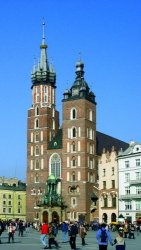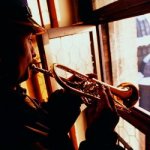Kraków Hourly Trumpet Signal
Every full hour a golden trumpet shows above Krakow's central Grand
Square in the west window just below the spire of the higher,
municipal tower of the Basilica of the Virgin Mary's. Then a
characteristic trumpet signal, known and dear to every Pole, resounds
all over the city's Old Town historical district. All of a sudden the
melody comes to an abrupt end. Next it is played towards the east, the
south and the north. At noon the whole ritual is broadcast by the
Polish radio. The Kraków signal, or Hejnal Mariacki, dates back to the
Middle Ages when it announced the opening and the closing of the
city gates. The bugler also played it to alarm his fellow citizens
whenever he saw a fire or enemy forces. And the melody's abrupt
ending is said to commemorate a bugler shot through his throat by a
Tatar archer in 1241.

Bugles have always been played from Kraków towers and gates to announce the beginning and the end of the day. Travellers had to stay outside the city walls if they were caught by night near Kraków and wait until the gates were opened at sunrise.
What were the tunes played from the city's towers and the Royal Castle of Wawel? We will never know that. It is only known that when Kraków saw the influx of Hungarians in the late 14th c., as Queen Jadwiga, the future wife of King Jagiello, was about to ascend the throne, a hajnal (bugle-call) came here in a barrel of exquisite Hungarian wine. It came here and stayed to resound in Kraków's skies forever. It was probably first played by Hungarians, and later, when the guards of the Wawel and St. Mary's were changed, was taken over by the Poles.
Kraków is a world-unique city in which the medieval tradition of playing a bugle from a tower every hour has survived to this day. It has continued although the performers of St. Mary's bugle were by no means safe. Legend has it that the original bugle was interrupted when a Tartar arrow pierced the throat of the musician, taking his life. Another mortal accident on the Tower happened in 1901. Trumpeter Antoni Dollga managed to play three times: for the King (the window overlooking Wawel), for the Honourable Council (Cloth Hall and Main Square), for the Guests (the Barbican and the Florianska Gate). His fourth bugle (the east window, overlooking the Fire Service Headquarters) was never heard... In September 1939 the Nazi invaders banned the playing of the tune for several months. In 1980, bugs invaded the tower, and thus, for a few weeks the bugle was played from the Town Hall Tower.
Since 1927, there has been no need to come to Kraków to hear the
bugle, as it is broadcast by the Radio Kraków. In the buglers room at
the Tower, one can see the Marconi tube, more than seventy five years'
old and still operational, which transmits the tune of a golden
trumpet to the radio from which it is broadcast to the world.
Currently all you need is to turn on the radio at 12.00 noon Polish
time and tune in at Radio Kraków and you will hear the finest of
Kraków melodies. It is the world-oldest regular musical programme!

Who are the bugle players? There are people in Kraków, and not only in Kraków, who are able to recognise who plays the bugle infallibly. Once Omietana or Rusin, recently Skowronek or Kolton. The city has always had special feelings for the buglers. Originally they were called "the trumpeters from the tower", and were selected from among men of exemplary conduct, of 20-35 years of age, who could read and write. (The first woman to play the bugle from the tower was Anna Kula in 1993). Equally high requirements were set for professional members of fire service, who have had an uninterrupted record of service at the Tower since 1874, i.e. 130 years. During a 24-hour long shift each of the two buglers present plays the bugle 48 times. He precedes each round by pulling the rope of the tower clock. So first the hour strikes and then we hear.. tratatata... Unlike their predecessors, they have no need to watch if an enemy is approaching Kraków, or if a fire has broken out. Their only role is to play. As beautifully as they can. They can feel secure — they have a telephone connection with the earth. And, if, God forbid, the Tower caught fire (such things happened) — the fireman, who have had alpinist training, may evacuate themselves on a rope.